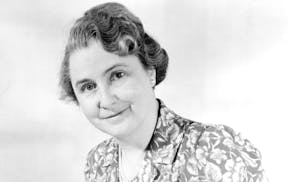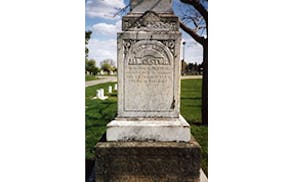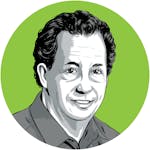Mayo Clinic scientist Dr. Earl Wood helped engineer one 20th-century breakthrough after another.
During World War II, his team used a human centrifuge and test flights over southern Minnesota to help enhance pressurized G-suits worn by fighter pilots to reduce high-altitude blackouts.
"The G-suit made the impossible possible," sound barrier-breaking pilot Chuck Yeager said.
Wood went on to patent an ear-clamp oximeter in 1955 to measure oxygen levels without drawing blood — a precursor to today's fingertip tests. And he helped develop a green dye to diagnose heart defects, among his other cardiac advancements, such as catheterization techniques using flexible cords snaking from legs and arms into heart chambers to analyze ticker issues. Every medical clinic and Air Force pilot still routinely use Wood's innovations today.
Still, even brilliant minds can have their bonehead moments. One summer day in 1935, Wood and his soon-to-be wife, Ada Peterson, set out for a picnic along the Mississippi River in their 1926 Ford Model T. They called the coupe "Ours" because together they kicked in the $25 purchase price — plus patches for the frequently flat tires.
"While setting up the picnic and bringing out the food, Earl noticed out of the corner of his eye Ours rolling through the grass. He had forgotten to set the parking brake!" according to Andrew Wood, 71, Earl's biographer and the youngest of his four children.
Earl had been captain of the football and basketball teams at Mankato High School, and football captain at Macalester College. But despite his athleticism, he was "unable to catch the car and stop it," his son wrote, explaining how his future parents "watched as Ours rolled over the cliff and met an untimely death below the bluffs of the Mississippi."
"He was not an absent-minded professor. In fact, I'd say he was just the opposite," Andrew Wood said from his home in Rochester, near the Mayo lab where his father worked for nearly 40 years. Andrew's book, "Life at High G-Force," detailing his father's staggering leadership skills and accomplishments, was published last year by the Mayo Clinic Press.
In the book's foreword, Mayo's aerospace medicine director in Arizona echoed the opinion that Earl Wood was far from absent-minded.
"His way of teaching was remarkable in that he was fully present and completely focused on the person he was interacting with, as if nothing else existed at that moment," Dr. Jan Stepanek wrote. "His dedication, focus, knowledge, integrity, and honesty made him more than just a brilliant teacher; he was also an incredible role model."
Born in Mankato in 1912, the fifth of six farm kids, Wood juggled odd jobs to offset his education costs during the Depression. He was a lifeguard at his family's beach resort on Lake Washington near Mankato and delivered ice blocks in a horse-drawn wagon to Mankato homes. He washed dishes at the Dutch Maid in St. Paul and helped a Grand Avenue mortician embalm bodies.
After earning a medical degree and doctorate through the physiology department at the University of Minnesota Medical School, Wood researched hearts and lungs at a Harvard University lab. Mayo Clinic officials tried to woo him back to Minnesota but he initially turned down their overtures.
His career trajectory changed, however, when he and Ada attended a 1942 movie called "Dive Bomber," starring Errol Flynn and Fred MacMurray. The film showed how flying planes higher and faster was causing pilots to pass out and crash from gravitational forces. "Recognizing the physiological challenges of high-altitude flight depicted in this movie," his son wrote, Wood changed his mind and joined Mayo's Aero Medical Laboratory.
That's where he led a team using a centrifuge to simulate the gravitational forces pilots faced, measuring blood pressure and other factors causing high-altitude blackouts. The team developed G-suits with bladders that kept more blood flowing to the brain. Wood's team also invented a so-called straining maneuver, enabling pilots to control their breathing with grunts and shouts and tightening their legs to increase blood pressure and improve gravitational tolerance.
Despite early skepticism, Andrew Wood writes, "fighter pilots quickly realized that with the combination of the straining maneuver and the G-suit, they could outmaneuver enemy airplanes in aerial combat."
German pilots had faster and more advanced planes at the end of World War II, but the Mayo G-suits helped Allied pilots rout the Nazi flyers. Wood was tapped again to dust off Mayo's centrifuge in 1958 when NASA was launched after the Soviets sent Sputnik into outer space.
Andrew Wood, an ergonomics consultant and former General Mills manager, says his father always rebuffed the notion that he invented G-suits. His book details Wood's humility as one of the keys to his leadership. But when he died 15 years ago at age 97, the New York Times called him "an essential member of the team that invented a revolutionary pressurized garment, the G-suit."
His father, Andrew said, "was a unique guy who understood science and could analyze data, but his leadership skills were so natural — always emphasizing an individual's strengths and ignoring their weaknesses."
Curt Brown's tales about Minnesota's history appear every other Sunday. Readers can send him ideas and suggestions at mnhistory@startribune.com. His latest book looks at 1918 Minnesota, when flu, war and fires converged.

Minnesota History: Ad man turned Paul Bunyan into a folklore icon

Minnesota History: James Griffin used persistence to blaze a trail for St. Paul's Black police officers

Minnesota History: For Granite Falls doctor who tested thousands of kids for TB, new recognition is long overdue

Minnesota History: A New Ulm baker wearing a blanket fell to friendly fire in the U.S.-Dakota War

